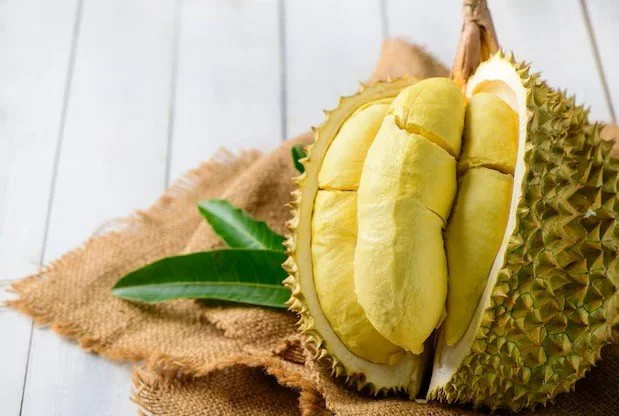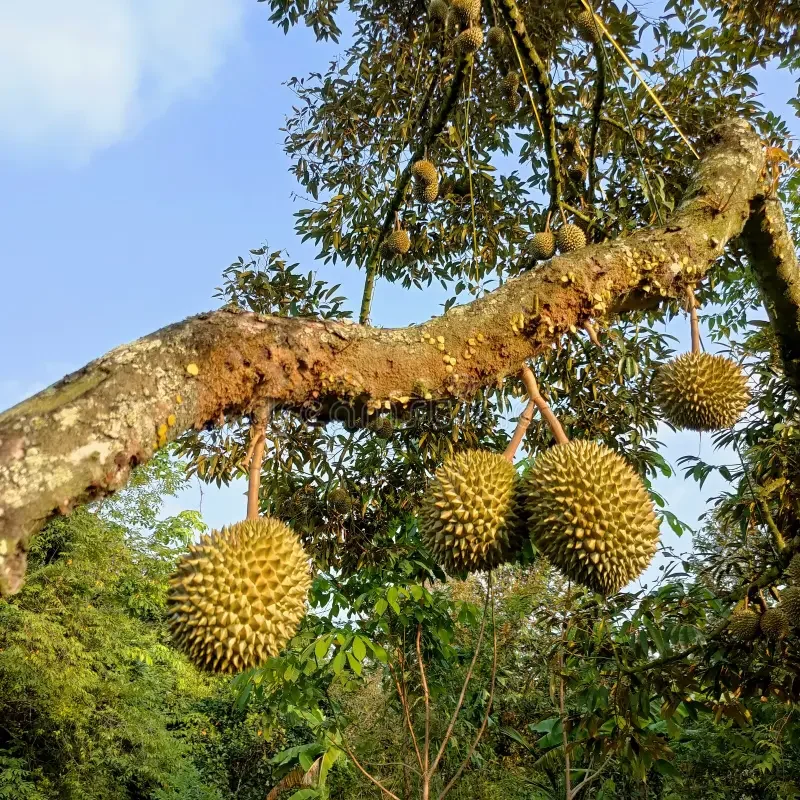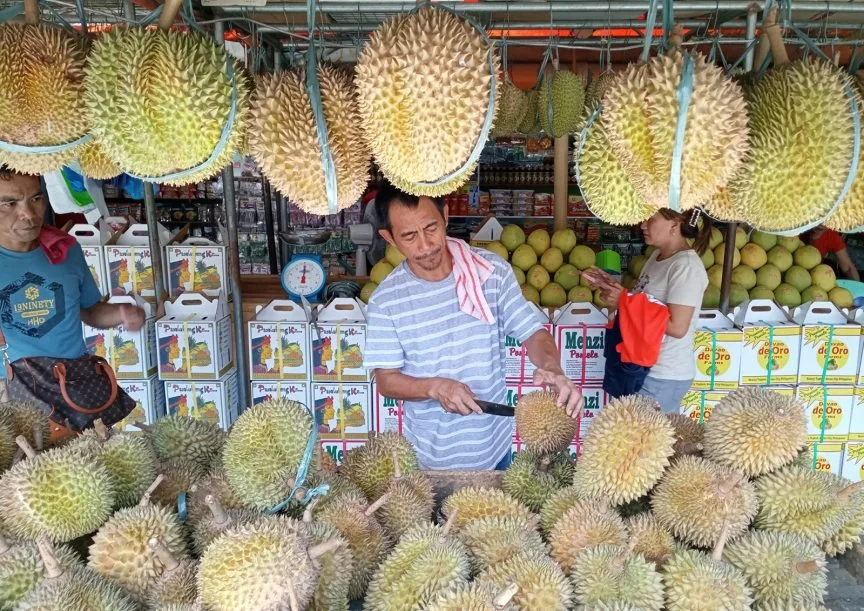Durian-The king of fruits
The King of Fruits: A Tale of Thorny Splendor, Heavenly Taste, and Davao’s Crown
There is a fruit that does not simply grow; it announces its presence with the solemn, weighty authority of a monarch. To cross its path is to have an opinion, often fiercely held. It is a fruit that has been described, with equal parts reverence and disgust, as smelling like hell but tasting like heaven. This is the durian. And while its kingdom spans the lush landscapes of Southeast Asia from the orchards of Thailand to the jungles of Malaysia and Indonesia, there is a region that has carved out a singular, powerful identity with this most divisive of fruits: the island of Mindanao in the Philippines, and its vibrant, durian-pulsing heart, Davao.
To understand the durian is to embark on a journey that transcends mere gastronomy. It is a voyage into the heart of evolutionary biology, a deep dive into complex chemistry, a lesson in cultural anthropology, and a masterclass in agricultural economics. It is a story of a tree that is a forest titan, a flower that dances with bats under the moonlight, and a fruit so fiercely protected by a fortress of thorns that it seems to guard its secrets with deliberate malice. And at the center of this story, for the Philippines, is Davao City, the self-proclaimed and widely acknowledged "Durian Capital of the Philippines." This is not just a marketing slogan. It is a testament to a deep, symbiotic relationship between a city and its king.
Our story begins not in a market, but in the steamy, biodiverse rainforests where the durian tree, primarily Durio zibethinus, holds court. These are not the manageable, pruned orchard trees one might imagine. In its wild, primordial state, the durian is a behemoth, a canopy giant that can soar to heights of over 150 feet, its straight, massive trunk buttressed by great, woody flanges that anchor it firmly in the thin tropical soils. It is a patient organism, a long-term investment in the ecosystem. A tree grown from seed may take a decade or more to first fruit, a long childhood spent gathering strength for its eventual, spectacular performance.
The leaves of the durian are a subtle prelude to the main event. They are elegant and elongated, with a glossy, dark green top and an underside often covered in fine, silvery or golden scales that catch the dappled jungle light, making the entire tree shimmer when stirred by a breeze. For most of the year, it is a quiet, stately presence. But then, with the arrival of the seasonal rains, the tree prepares for its reproductive drama. The flowers of the durian are as peculiar and specialized as the fruit they will become. They do not bloom in a sunny, bee-friendly display. Instead, as dusk falls, the tree’s trunk and older branches become adorned with clusters of large, pale, pendulous blossoms. These flowers open under the cover of darkness, and as they do, they release a potent, sour-buttery scent into the humid night air.
This fragrance is a specific, targeted beacon. It is not for bees or butterflies. It is a siren call for the durian’s primary pollinators: nectar-feeding bats. In a exquisite piece of evolutionary choreography, these bats, such as the Dawn Bat (Eonycteris spelaea), are drawn to the scent. As they plunge their heads into the flowers to drink the copious nectar, their fur becomes dusted with pollen. Flitting from tree to tree, they perform the crucial act of cross-pollination, ensuring the genetic diversity that keeps the durian lineage strong. This nocturnal romance, hidden from human eyes, is the fundamental first step in creating the King of Fruits. It’s a reminder that the durian’s entire existence is tied to the hidden rhythms of the night and the creatures that rule it.
Once pollinated, the fruit begins its long gestation, a three-to-four-month period of development that transforms a tiny ovary into one of the most formidable structures in the plant kingdom. The durian fruit is a capsule, a botanical term that barely does justice to its armoured magnificence. Its husk is a thick, semi-wooden carapace covered in sharp, pyramidal thorns. These are not mere prickles; they are robust, dangerous spines capable of deterring all but the most determined predators. This is nature’s ultimate protective packaging, a veritable fortress designed to safeguard the treasure within until the precise moment of ripeness.
And then, the fall. When a durian is ready, it does not simply drop; it detaches from its stem and plummets to the earth with a heavy, decisive thud, a sound that signals both danger and delight. In durian orchards, farmers often tell tales of the fruit’s lethal potential, and it is not uncommon to see them wearing hard hats during harvest season, a sobering precaution against a king that can literally crown you from above. This dramatic descent is the fruit's final act of independence, a signal that its internal transformation is complete.
This brings us to the great schism, the moment of truth that occurs when the husk is breached: the smell. What is it, precisely, that makes the durian smell, as so many have claimed, "like hell"? The answer lies in a complex and potent chemical cocktail that has fascinated scientists for decades. Advanced analytical techniques have identified a veritable orchestra of volatile compounds. The primary culprits belong to the sulfur family, the same chemical clan that gives garlic, skunks and rotten eggs their distinctive punch. Compounds like ethanethiol and propanethiol provide the initial, offensive, oniony-sewage-gas aroma that so offends the uninitiated.
But the story is not one-dimensional. Interwoven with these sulfurous notes is a surprising array of other chemicals. Esters provide fruity, sweet undertones, reminiscent of apples and citrus. Aldehydes and ketones contribute layers of caramel, vanilla and roasted onion. The durian’s scent is not a single note of putrescence but a incredibly complex symphony of contrasting aromas: sweet and savory, fruity and foul, heavenly and hellish all at once. The unique genetic makeup of the durian means it has a particularly high activity of the enzymes that create these sulfur compounds, making its aroma uniquely potent. This biochemical brilliance explains why the experience is so divisive; one person’s brain may latch onto the sulfur compounds, while another’s perceives the sweet esters more strongly. It is a fruit that literally plays on the neurological differences between people.
But to focus only on the smell, to be repelled and walk away, is to commit a profound act of culinary cowardice. For those who brave the aroma, the reward is the "taste like heaven." The edible part of the durian is not the fruit flesh itself, but the aril, the creamy, custard-like pulp that surrounds the seeds. Its texture is legendary an indescribably rich and smooth consistency that coats the palate like the most decadent French custard or a rich, unsalted butter. The flavor profile is where the magic truly happens. It is a staggering complexity that unfolds in waves. The first impression is one of profound, sweet richness, like a dense caramel flan or a sweet, aged cheese. This is followed by subtle notes of vanilla, roasted almonds and a hint of savory, onion-like depth that prevents the experience from being cloying. It is a flavor that evolves, lingers, and satisfies on a deep, almost primal level. This is why the "smells like hell, tastes like heaven" paradox is so perfect and so enduring. It is a fruit that demands you overcome prejudice to discover sublime reward.
Now, let us bring this global narrative to a specific, vibrant, and crucial location: the Philippines, and more specifically, Davao. The island of Mindanao, with its rich volcanic soil, abundant rainfall, and tropical climate, provides an ideal environment for the durian tree. While the durian is enjoyed across the archipelago, it is in Davao where the culture, economy, and identity of the fruit have become most concentrated and refined. Davao City is not just a place where durian is sold; it is a place where durian is lived.
The rise of Davao as the durian capital is a story of perfect geography meeting agricultural ambition. The slopes of Mount Apo, the country’s highest peak, provide the ideal terroir. The city and its surrounding provinces, such as Davao del Sur and North Cotabato, have embraced durian cultivation with a passion, transforming the landscape into a patchwork of orchards that drive a significant part of the local economy. Driving through the Durian Highway in the nearby town of Calinan, the presence of the king is unmistakable. Roadside stalls pile high with the thorny fruits, and the air carries a distinct, pungent sweetness.
The durian season in Davao, typically peaking from August to October, is a time of celebration and community. The city plays host to the annual Kadayawan Festival, a thanksgiving event for nature’s bounty where the durian is undoubtedly one of the stars. During this period, the public spaces, particularly the Magsaysay Park Fruit Complex, transform into a durian epicenter. Here, under the glow of makeshift lights, the ritual unfolds. Vendors, with hands toughened by years of practice, expertly wield cleavers to split open the stubborn husks along their natural sutures, revealing the creamy, golden pods within. Families, groups of friends, and adventurous tourists gather on plastic stools, digging into the flesh with their hands, the sticky richness a source of shared joy and conversation. It is a messy, unpretentious, and utterly authentic culinary experience.
The Philippines has also developed its own beloved cultivars, each with its own personality and devoted following. While the Thai Monthong and the Malaysian Musang King are globally famous, Davao has its own champions. The Duyaya is a local favorite, known for its relatively thin skin, small seeds and thick, yellow and sweet-savory flesh with a less intense odor, making it a great introductory durian. The Arancillo, another Davao star, is prized for its deep yellow, fine-textured, and very sweet aril. The Puyat is known for its excellent form and high yield, with a bittersweet flavor profile that appeals to connoisseurs. These local varieties are a point of pride, representing decades of careful selection and cultivation by Filipino farmers, and they hold their own against any international competitor.
The economic impact of durian in Davao and the wider Davao Region is immense. It provides a livelihood for thousands of farmers, traders and vendors. The value chain extends from the orchard owners to the seasonal pickers, the transporters, the market stallholders and the processors who turn the pulp into candies, pastes, and ice cream. In recent years, a monumental shift has occurred: the opening of the Chinese market to fresh Philippine durian. This trade agreement has the potential to revolutionize the industry, offering Filipino farmers access to the world's largest and most durian-hungry consumer base. This is not just an export opportunity; it is a geopolitical and economic validation of the quality of Davao's durian, positioning the Philippines as a major global player.
Beyond the fresh fruit, the culinary creativity surrounding durian in the Philippines is a testament to its cultural integration. Of course, it is enjoyed fresh, straight from the shell. But it also finds its way into a host of local delicacies. Durian candies are a popular pasalubong (souvenir gift), offering a sweet, chewy, and less pungent taste of the fruit. Durian jam is a rich, spreadable delight. In desserts, it is blended into ice cream, creating a flavor that is uniquely Filipino, or baked into rolls and pastries. A particularly decadent Davao treat is durian shake, where the fresh pulp is blended with ice and a little sugar: a cold, creamy and intensely flavorful drink that is the perfect antidote to the tropical heat. There are even adventurous chefs experimenting with durian in savory dishes, using its creamy, savory-sweet profile in sauces or as a glaze.
The durian is also deeply woven into the local fabric of beliefs and traditional medicine. Much like in other parts of Southeast Asia, the concept of "heaty" and "cooling" foods prevails. Durian is considered a "heaty" food, believed to increase body temperature. It is commonly said that eating too much durian can cause a sore throat, indigestion or a feeling of discomfort. The folk remedy is to drink water from the hollows of the empty durian shell, which is believed to possess "cooling" properties that balance the "heat." While modern science might explain any discomfort through the fruit's high sugar, fat, and fiber content challenging the digestive system, the cultural practice persists, a charming example of empirical wisdom passed down through generations.
In conclusion, the durian tree from its majestic presence in the rainforest to its thorny fruit on a Davao roadside stall, is a living paradox. It is a biological marvel whose existence is tied to the flight of bats and the complex language of chemistry. It is an economic engine that sustains communities and fuels international trade. It is a cultural icon that commands reverence and inspires passion. And in Davao, it has found a capital, a place where its hellish scent and heavenly taste are not a contradiction, but the very source of its legend. The durian challenges us to look beyond superficial impressions, to embrace complexity, and to seek reward in the most unlikely of packages. It is and will always be, a king-demanding, powerful, spiky on the outside, incomparably rich within and, in the heart of Mindanao, truly at home.










